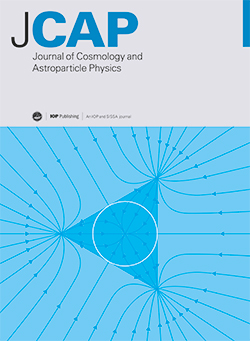从普朗克 CMB 数据中寻找宇宙学对撞机
IF 5.3
2区 物理与天体物理
Q1 ASTRONOMY & ASTROPHYSICS
Journal of Cosmology and Astroparticle Physics
Pub Date : 2024-09-04
DOI:10.1088/1475-7516/2024/09/016
引用次数: 0
摘要
在本文中,我们首次对宇宙学对撞机物理学进行了全面的 CMB 数据分析。暴胀过程中的新重型粒子会在原始相关器中留下印记,而这些印记在今天的宇宙学测量中是可以观测到的。这一非凡的探测通道为探测极高能量下的新物理学提供了无与伦比的机会。在这里,我们开始在普朗克遗留发布的宇宙微波背景(CMB)数据中寻找这些遗迹信号。在理论方面,以宇宙学自举的最新进展为指导,我们首先提出了一系列分析双谱模板,其中包含了宇宙学对撞机物理的独特特征。我们考虑的因素包括挤压极限中的振荡信号、旋转场的角度依赖性,以及来自非对称声速效应的几种新形状。在观测方面,我们应用最近开发的管道--CMB 双谱估计器(CMB-BEST)--有效地分析三点统计,并在普朗克 2018 年温度和偏振数据中直接搜索这些新模板。我们报告了对这些新模板的严格 CMB 约束。此外,我们还进行了参数扫描,以寻找具有最大意义的最佳拟合值。在对撞机模板的基准例子中,我们发现 fNL = -91 ± 40 的置信度为 68%。考虑到 "看别处 "效应后,我们得到的最大调整显著性为 1.8σ。总的来说,我们在普朗克数据中没有发现宇宙学对撞机信号的重要证据。然而,我们的创新分析,连同最近利用 BOSS 数据所做的工作[107],为探测宇宙学对撞机奠定了基础,并展示了在即将进行的宇宙学探测中发现暴胀期间新的重粒子的潜力。本文章由计算机程序翻译,如有差异,请以英文原文为准。
Searching for cosmological collider in the Planck CMB data
In this paper, we present the first comprehensive CMB data analysis of cosmological collider physics. New heavy particles during inflation can leave imprints in the primordial correlators which are observable in today's cosmological surveys. This remarkable detection channel provides an unsurpassed opportunity to probe new physics at extremely high energies. Here we initiate the search for these relic signals in the cosmic microwave background (CMB) data from the Planck legacy release. On the theory side, guided by recent progress from the cosmological bootstrap, we first propose a family of analytic bispectrum templates that incorporate the distinctive signatures of cosmological collider physics. Our consideration includes the oscillatory signals in the squeezed limit, the angular dependence from spinning fields, and several new shapes from nontrivial sound speed effects. On the observational side, we apply the recently developed pipeline, CMB Bispectrum Estimator (CMB-BEST), to efficiently analyze the three-point statistics and search directly for these new templates in the Planck 2018 temperature and polarization data. We report stringent CMB constraints on these new templates. Furthermore, we perform parameter scans to search for the best-fit values with maximum significance. For a benchmark example of collider templates, we find fNL = -91 ± 40 at the 68% confidence level. After accounting for the look-elsewhere effect, the biggest adjusted significance we get is 1.8σ. In general, we find no significant evidence of cosmological collider signals in the Planck data. However, our innovative analysis, together with the recent work [107] using the BOSS data, sets the stage for probing cosmological collider and demonstrates the potential for discovering new heavy particles during inflation in forthcoming cosmological surveys.
求助全文
通过发布文献求助,成功后即可免费获取论文全文。
去求助
来源期刊

Journal of Cosmology and Astroparticle Physics
地学天文-天文与天体物理
CiteScore
10.20
自引率
23.40%
发文量
632
审稿时长
1 months
期刊介绍:
Journal of Cosmology and Astroparticle Physics (JCAP) encompasses theoretical, observational and experimental areas as well as computation and simulation. The journal covers the latest developments in the theory of all fundamental interactions and their cosmological implications (e.g. M-theory and cosmology, brane cosmology). JCAP''s coverage also includes topics such as formation, dynamics and clustering of galaxies, pre-galactic star formation, x-ray astronomy, radio astronomy, gravitational lensing, active galactic nuclei, intergalactic and interstellar matter.
 求助内容:
求助内容: 应助结果提醒方式:
应助结果提醒方式:


